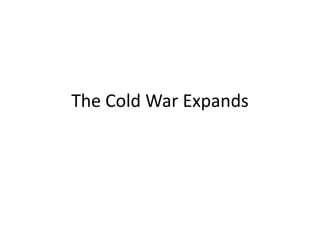
The Cold War Expands
- 1. The Cold War Expands
- 2. Global Cold War through 1960
- 3. Objectives • Describe the causes and results of the arms race between the United States and Soviet Union. • Explain how Eisenhower’s response to communism differed from that of Truman. • Analyze worldwide Cold War conflicts that erupted in Eastern Europe, the Middle East, and other places. • Discuss the effects of Soviet efforts in space exploration.
- 4. Terms and People • arms race − race in which countries compete to build more powerful weapons • mutually assured destruction − policy in which the United States and the Soviet Union hoped to deter nuclear war by building up enough weapons to destroy each other • John Foster Dulles − diplomat and secretary of state under President Eisenhower • massive retaliation − policy of threatening to use massive force in response to aggression
- 5. Terms and People (continued) • brinkmanship – belief that only by going to the brink of war could the U.S. prevent war • Nikita Khrushchev − leader of the Soviet Union after Stalin’s death • nationalize − to place under government control • Suez crisis − crisis in which Britain and France attempted to seize control of the Suez canal from Egypt
- 6. Terms and People (continued) • Eisenhower Doctrine − President Eisenhower’s policy that stated the U.S. would use force to help nations threatened by communism • Central Intelligence Agency (CIA) − American intelligence-gathering organization • National Aeronautics and Space Administration (NASA) − American organization that coordinates the space-related efforts of scientists and the military
- 7. What methods did the United States use in its global struggle against the Soviet Union? By 1950, the United States and the Soviet Union were world superpowers. Tensions ran high as each stockpiled weapons and struggled for influence around the globe.
- 8. On September 2, 1949, the balance of power between the U.S. and the Soviet Union changed forever. That day, the Soviet Union tested an atomic bomb. The threat of nuclear war suddenly became very real.
- 9. In response, Truman ordered scientists to produce a hydrogen bomb—a bomb 1,000 times more powerful than the atomic bomb. In 1952, the U.S. tested the first H-bomb. The next year, the Soviets tested their own H-bomb. The arms race had begun.
- 10. •In time, the United States and the Soviet Union would build enough nuclear weapons to destroy each other many times over. •Both sides hoped that this program of mutually assured destruction would serve as a deterrent.
- 11. For many, however, the existence of so many weapons was a further threat to peace. Nuclear Warhead Proliferation Year U.S. USSR Britain France China 1945 6 0 0 0 0 1950 369 5 0 0 0 1955 3,057 200 10 0 0 1960 20,434 1,605 30 0 0 1965 31,642 6,129 310 4 1
- 12. Americans reacted to the nuclear threat by following civil defense guidelines. Families built bomb shelters in backyards. Students practiced “duck and cover” drills at school.
- 13. •President Eisenhower encouraged a civil defense program, believing that if there was another major war, it would be nuclear. •Unlike Truman, Eisenhower was not interested in fighting communism by building conventional forces. •Instead, he and his secretary of state John Foster Dulles focused on stockpiling nuclear weapons. They believed that by meeting communist threats with U.S. threats of massive retaliation and brinkmanship they could prevent war.
- 14. Joseph Stalin died in 1953. After a brief power struggle, he was succeeded by Nikita Khrushchev. Cold War hostilities eased for a time, with the new leader speaking of “peaceful coexistence.”
- 15. • When Egypt recognized communist China, the United States pulled its offer to fund the building of a dam on the Nile River. Yet hopes for peace faded quickly. The Suez crisis added to the tensions • The Egyptian president threatened to nationalize the Suez canal, cutting off the flow of oil to Europe. • The canal had been managed by a British–French company. These two nations used this as an excuse to seize control of the canal. • Eisenhower was furious.
- 16. Nuclear weapons would not be used in the world’s “hot spots.” Global Cold War, 1946−1956
- 17. Other methods, however, would be used to help nations threatened by communism. • Eisenhower used the Eisenhower Doctrine to justify sending troops to quell conflicts. • He also approved secret CIA operations to promote American interests abroad.
- 18. While the United States worked to contain communism on the ground, they suffered a serious setback in space. In 1957, the Soviets launched the Sputnik I satellite into orbit around Earth. Fearing Soviet dominance of space, Congress approved funding to create NASA. The arms race was now joined by a space race.